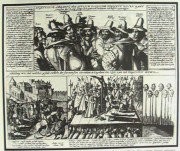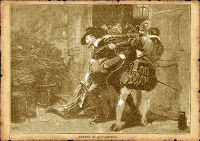 Life is sort of insane at the moment and since Guy Fawkes day (November 5) is almost upon us, I’m recycling a post about fireworks from 2009.
Life is sort of insane at the moment and since Guy Fawkes day (November 5) is almost upon us, I’m recycling a post about fireworks from 2009.
Occasionally people ask me if Halloween is celebrated in England and I tell them that now it’s quite a big deal. I’m surprised that the sweet-loving English took so long to figure out that any day when candy is given away is worth adopting. But when I was growing up we preferred to burn Catholics in effigy. You can read some earlier Risky posts about the Gunpowder Plot, Diane’s in 2007 and mine in 2005, so today I thought I’d talk about fireworks (and who hasn’t written a Vauxhall Gardens scene with fireworks?)
Like so many other inventions, fireworks originated in China, possibly as early as the ninth century, the legend being that common kitchen ingredients, saltpeter, sulfur, and charcoal combined to explode. So the early emphasis was on loud bangs, thought to scare off evil spirits. When fireworks came west and were adopted by the royal courts of Europe in the Renaissance, the color scheme was somewhat limited at first, mostly in shades of amber, so the emphasis was on elaborate structures built to display the fireworks. The Italian style featured fake buildings, decorated with painted allegorical figures or flowers, whereas the German (Northern School) preferred one centerpiece, such as a figure of Cupid, from which the fireworks emerged.
 By the eighteenth century more colors were added to the repertoire and public firework displays became elaborate affairs, often with music, and frequently lasting a couple of hours. The illustration at left is a detail of a fireworks display in Green Park, London, in 1763. One of the most interesting things about this print is that it’s an early 3-D experiment known as a vue d’optique–the words inside the explosion are Vivat Rex in reverse, because the print was designed to be viewed through a mirrored viewer. You can read more about it here.
By the eighteenth century more colors were added to the repertoire and public firework displays became elaborate affairs, often with music, and frequently lasting a couple of hours. The illustration at left is a detail of a fireworks display in Green Park, London, in 1763. One of the most interesting things about this print is that it’s an early 3-D experiment known as a vue d’optique–the words inside the explosion are Vivat Rex in reverse, because the print was designed to be viewed through a mirrored viewer. You can read more about it here.
One of the most famous public fireworks displays was the one in 1749 to celebrate the end of the war for Austrian succession. Handel was commissioned to write the music (Music for the Royal Fireworks), the “machine” from which the fireworks were to be set off took four months to build and 11,000 fireworks were designed by an Italian team led by the noted Gaetano Ruggieri. But the English technicians appointed to set off the fireworks got in a fight with the Italians and half of them were set off prematurely. The rest were never set off. Several spectators died in freak accidents–drowning, falling out of trees. When Princess Di and Prince Charles married in 1981, an attempt was made to replicate this firework display, and it was a dud then, too–“Wedding 6: Fireworks 0” according to the Evening Standard.
 One intriguing fact that came out when I was reading about fireworks was that many of the manufacturers were family businesses that spanned several generations. Brocks Fireworks, the oldest English company, was founded early in the eighteenth century and started a tradition of public firework displays for the general public in 1826, and given at the Crystal Palace after 1865. The company was eventually bought out by the now defunct Standard Fireworks. More info on English firework companies and some quite gorgeous artwork here.
One intriguing fact that came out when I was reading about fireworks was that many of the manufacturers were family businesses that spanned several generations. Brocks Fireworks, the oldest English company, was founded early in the eighteenth century and started a tradition of public firework displays for the general public in 1826, and given at the Crystal Palace after 1865. The company was eventually bought out by the now defunct Standard Fireworks. More info on English firework companies and some quite gorgeous artwork here.
Do you have a favorite fictional fireworks scene? Or, do you celebrate Fireworks Day?
 Although he wasn’t the ringleader, it’s Fawkes’ name that is associated with this band of fanatics. James I decreed that the day after the discovery of the plot, November 5, was to be celebrated as a day of deliverance. Traditionally a “guy,” an effigy, is displayed in the weeks before the holiday, and children beg money to buy fireworks. Then the guy is burned on a bonfire, fireworks are set off, and various disgusting foods (like potatoes roasted in the embers, black on the outside, crunchy on the inside) are consumed. The trend nowadays is to encourage inside parties and official fireworks celebrations to keep the hospital emergency rooms clear.
Although he wasn’t the ringleader, it’s Fawkes’ name that is associated with this band of fanatics. James I decreed that the day after the discovery of the plot, November 5, was to be celebrated as a day of deliverance. Traditionally a “guy,” an effigy, is displayed in the weeks before the holiday, and children beg money to buy fireworks. Then the guy is burned on a bonfire, fireworks are set off, and various disgusting foods (like potatoes roasted in the embers, black on the outside, crunchy on the inside) are consumed. The trend nowadays is to encourage inside parties and official fireworks celebrations to keep the hospital emergency rooms clear. Although he wasn’t the ringleader, it’s Fawkes’ name that is associated with this band of fanatics. James I decreed that the day after the discovery of the plot, November 5, was to be celebrated as a day of deliverance. Traditionally a “guy,” an effigy, is displayed in the weeks before the holiday, and children beg money to buy fireworks. Then the guy is burned on a bonfire, fireworks are set off, and various disgusting foods (like potatoes roasted in the embers, black on the outside, crunchy on the inside) are consumed. The trend nowadays is to encourage inside parties and official fireworks celebrations to keep the hospital emergency rooms clear.
Although he wasn’t the ringleader, it’s Fawkes’ name that is associated with this band of fanatics. James I decreed that the day after the discovery of the plot, November 5, was to be celebrated as a day of deliverance. Traditionally a “guy,” an effigy, is displayed in the weeks before the holiday, and children beg money to buy fireworks. Then the guy is burned on a bonfire, fireworks are set off, and various disgusting foods (like potatoes roasted in the embers, black on the outside, crunchy on the inside) are consumed. The trend nowadays is to encourage inside parties and official fireworks celebrations to keep the hospital emergency rooms clear.






